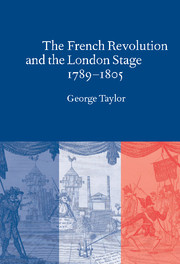Book contents
- Frontmatter
- Dedication
- Contents
- Acknowledgements
- Note on the text
- Introduction
- 1 England and France in 1789
- 2 The Revolution
- 3 From the Federation to the Terror
- 4 Dramatising (the) Terror
- 5 Performance and performing
- 6 The Shadow of Napoleon
- 7 Theatre and alienation
- Reflections towards a conculsion
- Notes
- Bibliography
- Index
Introduction
Published online by Cambridge University Press: 05 July 2014
- Frontmatter
- Dedication
- Contents
- Acknowledgements
- Note on the text
- Introduction
- 1 England and France in 1789
- 2 The Revolution
- 3 From the Federation to the Terror
- 4 Dramatising (the) Terror
- 5 Performance and performing
- 6 The Shadow of Napoleon
- 7 Theatre and alienation
- Reflections towards a conculsion
- Notes
- Bibliography
- Index
Summary
On 5 June 1783 the Montgolfier brothers launched a balloon that rose on a pillar of hot air above a bonfire in Annonay, central France.On 15 October their assistant, Pilâtre de Rozier, became the first man to fly. His balloon ascended above Paris, and, although the flight lasted only four and half minutes and rose only eighty-four feet, it provided its fearful occupant with an overview of a city which in the next ten years was to experience violent changes that have reverberated to the present day. The development of aviation might be considered to have been more momentous, but the ideas and strategies hammered out in the forge of the French Revolution have just as decisively shaped the values and consciousness of the last two centuries.Like the Montgolfiers' balloon, the theatre of late eighteenth-century London may also appear to have been a gorgeous and flimsy package floating free above the city. But, like the balloon, it was more than just a fabulous spectacle to delight ignorant spectators; its flight provides us with a vantage point from which to view and analyse changes happening below, for, just as hot air kept the Montgoliers' fragile craft aloat, so the shape and speed of theatrical change were invisibly determined by the heat of political and cultural conlict. This study will examine both the spectacle and the forces that shaped it.
- Type
- Chapter
- Information
- Publisher: Cambridge University PressPrint publication year: 2001



